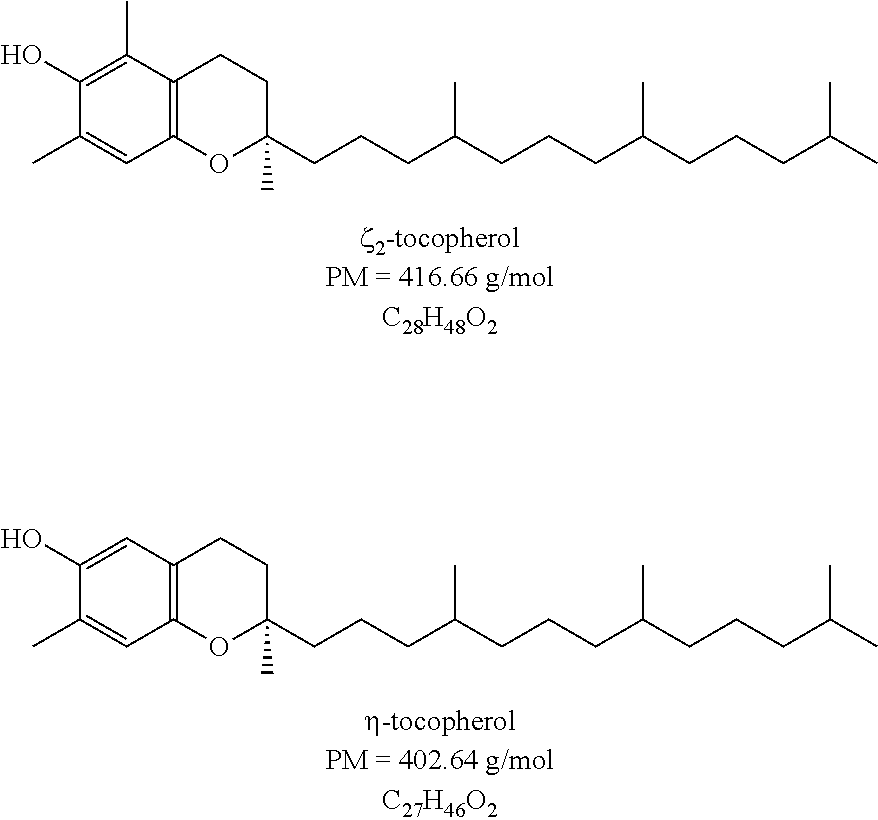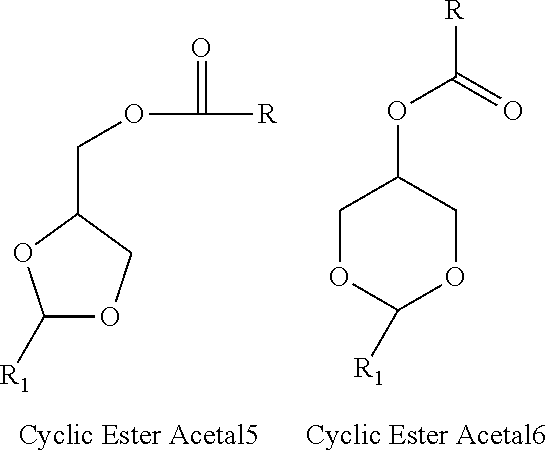Acetals Esters Produced from Purified Glycerin for Use and Application as Emollients, Lubricants, Plasticizers, Solvents, Coalescents, Humectant, Polymerization Monomers, Additives to Biofuels
a technology of glycerin and acetals, which is applied in the field of acetal monoesters and diesters, can solve the problems of restricted use of products in the market around the world
- Summary
- Abstract
- Description
- Claims
- Application Information
AI Technical Summary
Benefits of technology
Problems solved by technology
Method used
Image
Examples
example 1
Synthesis of Butyl Laurate, Isobutyl, Ethylhexyl Acetal Esters
[0038]In a glass reactor charge 2,105 grams of purified glycerol 95% (21.7 mol) equipped with condenser and water separator, and under continuous flow of nitrogen, add 5.0 grams of 85% phosphoric acid. Heat the reactional mass to 110° C. and add into the reaction mass 2248 (30.4 mol) grams of butyraldehyde or isobutyraldehyde or ethylhexaldehydein 60 minutes of addition. Keep reacting during 180 minutes until all the water of reaction (aprox. 390 grams) is separated.
[0039]Add 3472 grams of lauric acid 99% (17.38 mol) and 5 grams of dibutyltin dilaurate. Heat 120 minutes to 180° C. and react until it reaches an index of lower acidity that 3 mgkoh / grams of the product. Apply a vacuum of 100 mmHg to remove the excess of the reagents.
[0040]About 5700 grams of laurate of isobutyl acetal ester was obtained with 95% purity analyzed using gas chromatography coupled to a mass spectrometer (GC / MS).
[0041]The reaction yield of 95% as...
example 2
Synthesis of Butyl Capric Caprylate, Acetal Isobutyl
[0042]In a glass reactor charge 290 grams of purified glycerol 95% equipped with condenser and water separator, and under a continuous flow of nitrogen, add 5.0 grams of 85% phosphoric acid and 250 grams of butyraldehyde or isobutyraldehyde. Heat to 120° C. and maintain it reacting during 180 minutes. Add 462 grams of caprylic capric acid and 2 grams of dibutyltin dilaurate. Heat during 120 minutes to 180° C. and react until it reaches an index of acidity less than caprylate capric of. Apply
a vacuum of 100 mmHg to remove the excess of reagents.
[0043]The butyl capric caprylate, acetal isobutyl showed a purity of 97.5%.
example 3
Synthesis of Capric Caprylate Ethylhexyl Acetal
[0044]In a glass reactor charge 290 grams of purified glycerol 95% equipped with condenser and water separator, and under continuous flow of nitrogen, add 5.0 grams of phosphoric acid 85% and 500 grams of ethylhexyl aldehyde. Heat to 120° C. reacting for 180 minutes. Add 462 grams of caprylic and capric acid 2 grams of dibutyltin dilaurate. Heat to 180° C. for 120 minutes and react it until it reaches the acidity index less than caprylate capric of. Apply a vacuum of 100 mmHg to remove the excess of the reagents.
[0045]The apric caprylic ethylhexyl acetal showed a purity of 95.5%
PUM
| Property | Measurement | Unit |
|---|---|---|
| temperature | aaaaa | aaaaa |
| temperature | aaaaa | aaaaa |
| weight ratio | aaaaa | aaaaa |
Abstract
Description
Claims
Application Information
 Login to View More
Login to View More - R&D
- Intellectual Property
- Life Sciences
- Materials
- Tech Scout
- Unparalleled Data Quality
- Higher Quality Content
- 60% Fewer Hallucinations
Browse by: Latest US Patents, China's latest patents, Technical Efficacy Thesaurus, Application Domain, Technology Topic, Popular Technical Reports.
© 2025 PatSnap. All rights reserved.Legal|Privacy policy|Modern Slavery Act Transparency Statement|Sitemap|About US| Contact US: help@patsnap.com



